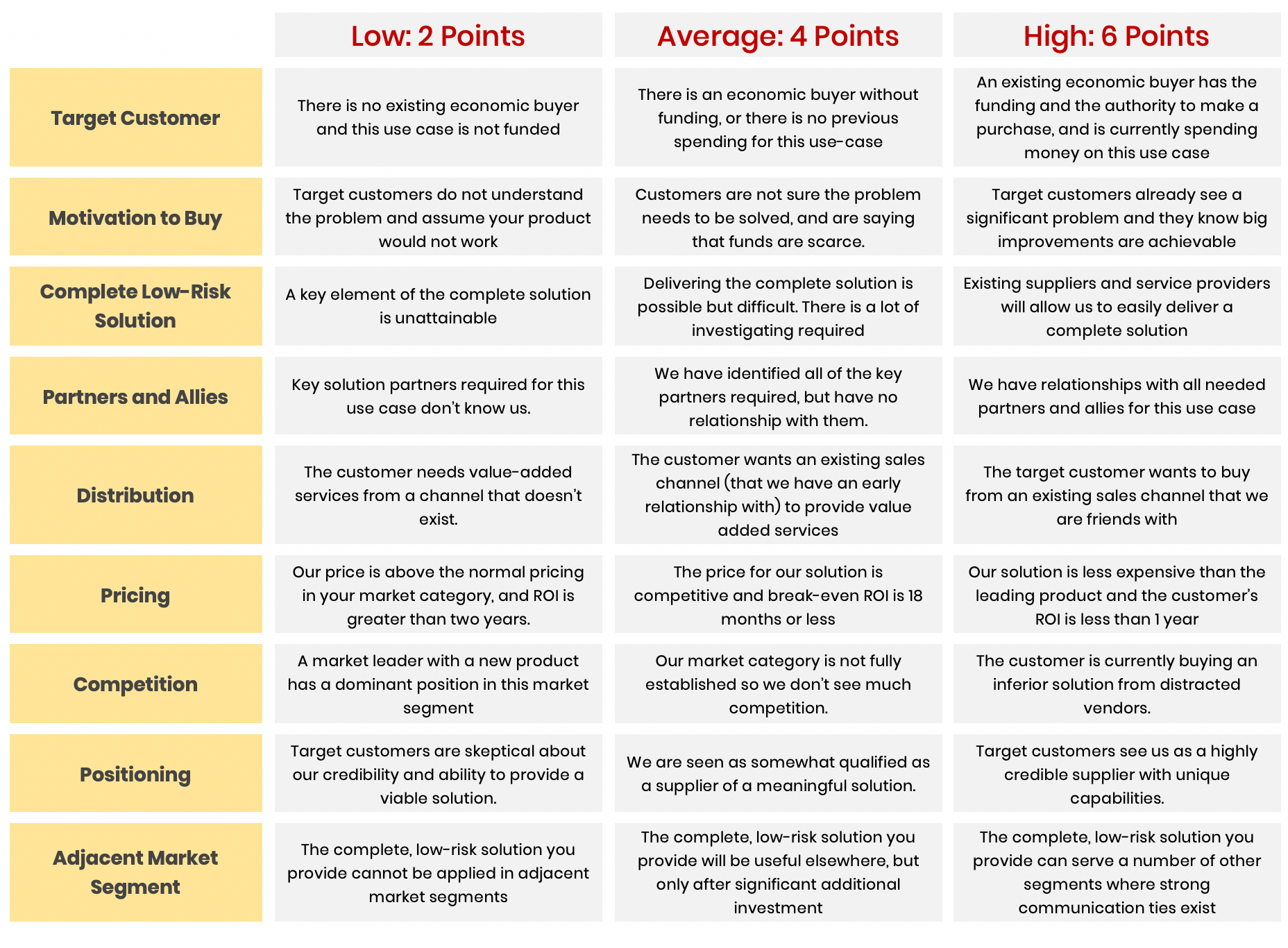Target Market Analysis and Selection
Use this target market analysis and selection framework to score your potential customers and their use case

This target market analysis and selection framework allows you to score each customer use case or application by quantifying the factors that reflect your ability to dominate that potential market segment. As outlined in our holistic go-to-market strategy page, the key factors required for success are divided into two groups:
Target Market Analysis and Selection Fundamentals
Group 1 – Market Success Factors
Target Customer Segment – Market segmentation and analysis is the process of defining the group (or groups) of customers who share similar needs and buying behaviors, and are more likely than others to adopt your solution. The starting point of any strategic endeavor is to select and describe an identifiable economic group of buyers that will be your initial target market or segment. If there are closely-related groups of buyers, it is essential to decide which one to focus on first.
Customer Profile and Motivation – Once you have assessed and prioritized the market opportunities, the next step is to describe the characteristics of the identifiable economic group of potential customers within that top growth opportunity. You must ensure that the target customer has an urgent reason to buy your product as soon as possible, and describe the specific motivation that will make the product valuable to them.
A Complete Low-Risk Offering – This step in your go-to-market strategy includes determining what makes the product “complete and low risk” in the eyes of your initial target customer. The complete solution is the set of products and services the target audience requires to overcome their fear of adoption or resistance to change. Your core product/technology must be augmented with a variety of services, intangible attributes, and ancillary products to be perceived as low risk.
Group 2 – Organizational Effectiveness Factors
Potential Partners – It is rare for a single organization to deliver every element of a complete solution. And today’s fiercely-competitive and fast-changing markets require the development of partnerships to reduce time to market and to deliver all of the elements of a complete solution. In most cases it will be necessary to form partnerships with technology, product and service providers to accelerate the delivery of a complete solution for the target customer and market.
Distribution Channels – An effective go-to-market strategy describes how a company communicates with and reaches its customer segment to deliver a value proposition. Identifying and preparing the best distribution channels to drive awareness throughout the market and sell the complete solution is a critical component. This step could potentially overlap with the last one in the sense that you may have identified channel partners. The key to identifying the best sales channel is to evaluate their willingness and ability to sell and deliver your complete solution.
Pricing Strategy – People in the mainstream do not spend money as freely as early adopters. And, at the same time, your suppliers, partners, and the sales channel need to be rewarded appropriately for selling to the target customer. Your pricing strategy needs to reflect these requirements. And you must help your customer perceive the value of your product offering and pay what it’s worth.
Competition – Analyzing competitors, both current and potential, is a critical step in order to clearly understand your long-term competitive advantages and differentiators. This begins with an assessment of the target market and identification of both “entrenched and potentially dangerous” competitive solutions. Analyze your capabilities and look for ways (in addition to trademarks and patents) to develop and maintain a competitive advantage, which are typically intangible attributes.
Unique Positioning – Proper positioning allows you to be seen as a credible provider of products and services to the target customer. Always remember that you don’t position your product, the market does. And the best way to help the market understand your product is to develop a comprehensive positioning “platform” that articulates the value delivered by your key differentiators. Once a positioning platform has been developed, the market infrastructure must be educated using the market relations process.
Next Target – Identifying an adjacent niche market that extends the progress you’ve made in your initial market segment is a game-changing strategy. This would be a second group of highly-motivated buyers, who reference each other before making a buying decision, and their application need fits with your technology or solution.
Market Segmentation Results
Effective market segmentation gives you clarity on:
✅ Who? — Which target segments are most attractive to address and which are not
✅ Why? — Understanding the customer’s motivation to buy, and how they buy
✅ What? — Creating offers that provide complete, compelling solutions
✅ Why you? — How to position the value you deliver in a way that is based on today’s buyer and market environment
Conclusion
Our market analysis and selection framework helps companies plan and execute a target market initiative that creates and sustains market leadership. It empowers teams to gain clarity regarding their product category and its stage of innovation-adoption. As a result, you will reach consensus on product marketing strategies, explore and prioritize target customer segments, manage vertical market initiatives, and define or execute go-to-market programs.

